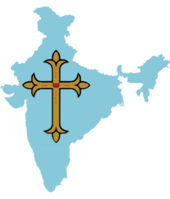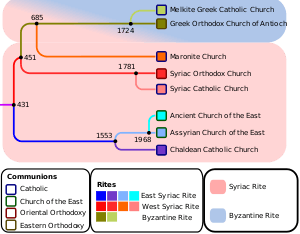Syro-Malabar Catholic Church
The Syro-Malabar Catholic Church or Church of Malabar Syrian Catholics (Classical Syriac: ܥܸܕܬܵܐ ܩܵܬܘܿܠܝܼܩܝܼ ܕܡܲܠܲܒܵܪ ܣܘܼܪܝܵܝܵܐ Edta Qatholiqi D'Malabar Suryaya; Latin: Ecclesia Syrorum Malabarensium, lit. "Church of the Malabar Syrians"), is an Eastern Catholic Major Archiepiscopal Church based in Kerala, India. It is an autonomous (in Latin, sui iuris) particular church in full communion with the Pope and the worldwide Catholic Church, with self-governance under the Code of Canons of the Eastern Churches (CCEO). The Church is headed by the Metropolitan and Gate of all India Major Archbishop George Cardinal Alencherry. The name Syro-Malabar is a prefix coined from the words Syriac as the church employs the East Syriac Rite liturgy, and Malabar which is the historical name for modern Kerala. The name has been in usage in official Vatican documents since the nineteenth century.[11]
| Syro-Malabar Catholic Church | |
|---|---|
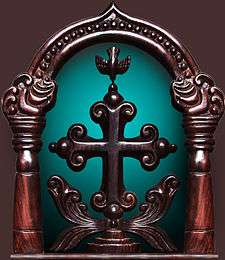 The Mar Thoma Sliva or Saint Thomas Cross, the symbol of the Syro-Malabar Church | |
| Type | Particular church (sui iuris) |
| Classification | Eastern Catholic |
| Orientation | Eastern Christianity (Syriac Christianity) |
| Scripture | Peshitta Malayalam POC Bible[1] |
| Theology | Catholic theology[2] |
| Polity | Episcopal polity |
| Pope | Francis |
| Major Archbishop | George Alencherry |
| Administration | Major Archiepiscopal Curia[3] |
| Parishes | 3,224 |
| Region | India and Nasrani Malayali diaspora[4] |
| Language | Liturgical Syriac, Suriyani Malayalam, Malayalam, English, Tamil, Hindi |
| Liturgy | East Syriac Rite (Liturgy of Addai and Mari) |
| Headquarters | St. Mary's Cathedral, Ernakulam, Kerala, India |
| Territory | India |
| Founder | Saint Thomas the Apostle |
| Origin | AD 52 (first century) Malabar Coast, Chola Empire |
| Separated from | Catholicos-Patriarch of the East of the Church of the East[5] |
| Branched from | Saint Thomas Christians[lower-alpha 1] |
| Absorbed | Province of India of the Church of the East (16th century)[9] |
| Separations | Chaldean Syrian Church (1870s) |
| Members | 4.25 million[10] |
| Clergy |
|
| Other name(s) | Marthoma Nasrani Catholic Church Malankara Chaldean Syriac Church (former name) Syrian Catholic (SC) (colloquial name for members) |
| Official website | Syro-Malabar Church |
The Syro-Malabar Church is the largest of the Thomas Christians denominations with over 4 million believers[10] and traces its origins to the evangelistic activity of Thomas the Apostle in the 1st century.[12][13][14][15] The earliest organised Christian presence in India dates to the 4th century, when Persian missionaries of the East Syriac Rite tradition, members of what later became the Church of the East, established themselves in modern-day Kerala and Sri Lanka.[16][17][18][19] The Church of the East shared communion with the Great Church (Catholicism and Orthodoxy) until the Council of Ephesus in the 5th century, separating primarily over differences in Christology. The Syro-Malabar Church employs a Latinised and Indianised variant of the Liturgy of Saints Addai and Mari belonging to the East Syriac Rite of the historic Church of the East, which dates back to 3rd century Edessa, Upper Mesopotamia.[20] As such it is a part of Syriac Christianity by liturgy and heritage.[21] After the schism of 1552, a faction of the Church of the East came in communion with the Holy See of Rome and the church collapsed. Through the Synod of Diamper of 1599, the Malabar Church was subjected directly under the authority of the Latin Catholic Archbishopric of Goa. After a half-century administration under the Goa Archdiocese, dissidents held the Coonan Cross Oath in 1653 as a protest. In response, Pope Alexander VII, with the help of Discalced Carmelite friars, by 1662, was able to reunite the majority of the dissidents with the Catholic Church. The Syro-Malabar Church descends from this East Syriac Rite hierarchy that reunited with the Holy See.[22] As per Mar Paremmakkal Thoma Kathanar's travelogue Varthamanappusthakam (dated to 1790), the Church was known then as the Malankara Chaldean Syriac Church (Malankare Kaldaya Suriyani Sabha).[23]
After over two centuries under the Latin Church's jurisdiction, in 1887, Pope Leo XIII fully separated the Syro-Malabars from the Latin Church, by establishing two Apostolic Vicariates, Thrissur and Changanassery, and in 1896, the Vicariate of Ernakulam was erected as well, under the guidance of indigenous Syro-Malabar bishops.[24] The Syro-Malabar Church in effect became an autonomous sui iuris Eastern church within the Catholic communion.[25] Catholicism within the Syro-Malabar Church is unique in that it has inculturated with traditional Hindu customs that form an integral part of traditional Indian culture. Scholar and theologian Placid Podipara describes the Church as "Hindu (Indian) in Culture, Christian (Catholic) in Religion, and Oriental (East Syriac Rite) in Worship."[26] The Church is predominantly of the Malayali ethnic group who speak Malayalam. Although an Eastern Church, the members are often colloquially known as Roman Catholic Syrian Christian (RCSC) in the state of Kerala. Following emigration of its members, eparchies (dioceses) have opened in other parts of India and in other countries to serve the Malayali diaspora living in the Western world. There are four eparchies (dioceses) outside of India. Saint Alphonsa is the Church's first canonized saint, followed by Saint Kuriakose Chavara, Saint Euphrasia, and Saint Mariam Thresia. It is one of the two Eastern Catholic churches in India, the other one being the Malankara Syrian Catholic Church which represents the faction of the Malankara Church that returned to full communion with the Holy See of Rome in 1930.[27]
| Part of a series on |
| Saint Thomas Christians |
|---|
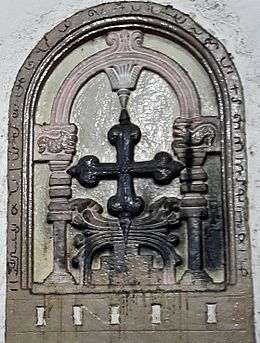 |
| History |
| Saint Thomas · Thomas of Cana · Mar Sabor and Mar Proth · Tharisapalli plates · Synod of Diamper · Coonan Cross Oath |
| Religion |
| Crosses · Denominations · Churches · Syriac language · Music |
| Prominent persons |
| Abraham Malpan · Paremmakkal Thoma Kathanar · Kayamkulam Philipose Ramban · Saint Kuriakose Elias Chavara · Varghese Payyappilly Palakkappilly · Mar Thoma I · Saint Alphonsa · Sadhu Kochoonju Upadesi · Kariattil Mar Ousep · Geevarghese Dionysius of Vattasseril · Geevarghese Mar Gregorios of Parumala · Geevarghese Ivanios · Euphrasia Eluvathingal · Thoma of Villarvattom |
| Culture |
|
Margamkali · Parichamuttukali · Cuisine · Suriyani Malayalam |
| Part of a series on |
| Eastern Christianity |
|---|
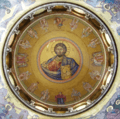 |
|
Main communions
|
|
Eastern liturgical rites |
|
Other topics
|
|
| Part of a series on |
| Particular churches sui iuris of the Catholic Church |
|---|
Latin cross and Byzantine Patriarchal cross |
| Particular churches are grouped by rite. |
| Alexandrian Rite |
| Armenian Rite |
| Byzantine Rite |
| East Syriac Rite |
| Latin liturgical rites |
| West Syriac Rite |
|
|
History

Pre-Coonan Cross Oath
The Persian Church of the East Patriarch Shemon VII Ishoyahb's unpopularity led to the schism of 1552, due to the patriarchal succession being hereditary, normally from uncle to nephew. Opponents appointed the monk Shimun VIII Yohannan Sulaqa as a rival patriarch. Sulaqa's subsequent consecration by Pope Julius III (1550–55) saw a permanent split in the Church of the East; and the reunion with Rome resulted in the formation of the modern-day Chaldean Catholic Church of Iraq.[28][29] Subsequently, Church of the East Bishop Mar Abraham of Angamaly was appointed by Pope Pius IV (1559–65) as Metropolitan and Gate of all India of the Thomas Christians (Archbishop of Angamaly), with letters to the Archbishop of Goa and the Bishop of Cochin dated to 1565.[5] In 1597, Mar Abraham of Angamaly died. Unfortunately, the Portuguese padroado Archbishop of Goa, Aleixo de Menezes, downgraded the Angamaly diocese and appointed the Jesuit Francisco Ros S.J. as Archbishop of Angamaly. Menezes held the Synod of Diamper in 1599 to bring the Thomas Christians under the complete authority of the Archbishopric of Goa. The oppressive rule of the Portuguese padroado eventually led to a revolt in 1653, known as the Coonan Cross Oath.[30] The Puthenkuttukar, or "New Party" faction, emerged after the Oath, which resisted the authority of the Portuguese padroado, under the leadership of Archdeacon Mar Thoma I, and formed the Malankara Church which entered into a new relationship with the Syriac Orthodox Church of Antioch.[31][32] The Pazhayakuttukar or "Old Party" faction that continued with the Catholic communion and employed the East Syriac (Persian) liturgy became the modern day Syro-Malabar Church.
Coonan Cross Oath
A protest took place in 1653 with the Coonan Cross Oath. Under the leadership of Archdeacon Thomas, the Thomas Christians publicly took an oath that they would not obey the Jesuit Bishops or the Pope.[33] Church historian KOOTHUR observes that "the 'Coonan Cross' revolution obviously was the final outbreak of the storm that had been gathering on the horizon of the ecclesial life of the St. Thomas Christians for over a century."
Rome sent Carmelites in two groups from the Propagation of the Faith to Malabar headed by Fr. Sebastiani and Fr. Hyacinth. Fr. Sebastiani arrived first in 1655 and began to speak directly with the metropolitan, Mar Thoma I. Fr. Sebastiani, with the help of Portuguese, gained the support of many, especially with the support of Palliveettil Chandy, Kadavil Chandy Kathanar and Vengoor Geevarghese Kathanar. These were the three of the four counselors of Thoma I, who had defected with Francisco Garcia Mendes, SJ, Archbishop of Cranganore, before the arrival of Sebastaini, according to Jesuit reports.[33]
Between 1661 and 1662, out of the 116 churches, the Carmelites claimed eighty-four churches, leaving the native metropolitan Thoma I with thirty-two churches. The eighty-four churches and their congregations were the body from which the Syro Malabar Catholic Church has descended. The other thirty-two churches and their congregations represented the nucleus from which the Malankara Orthodox Syrian Church, the Thozhiyur Church, Thoma Syrian (Reformed Syrians), and Syro-Malankara Catholic Church have originated.[34]
In 1665 Gregorios, a Bishop sent by the Syriac Orthodox Patriarch of Antioch, arrived in India. The independent group under the leadership of the Archdeacon welcomed him.[35] Though most of the St. Thomas Christians gradually relented in their strong opposition to the Western control, the arrival of Bishop Gregorios of the Syriac Orthodox Church in 1665 marked the beginning of a formal schism among the St. Thomas Christians. Those who accepted the West Syriac liturgical tradition of the Syriac Orthodox Church of Antioch of Gregorios became known as the Puthenkoor; they also continued to use the name "Malankara", the real name of the St. Thomas Christian community for the church. Those who joined the communion of Rome after the Synod of Daimper and remained in the communion even after the oath of bent cross, and those who joined the Catholic communion from the Puhenkoor Malankara church during the Carmelite period, came to be known as the Syro Malabar Church from the last decade of the Nineteenth century onwards.[35] Some of the churches not joined in the Angamaly Padiyola (1787) later became Latin churches, e.g. Mathilakom (Pappinivattom), Maliankara, Thuruthipuram, etc. One branch of the Syro Malabar Catholic church later left to form the Assyrian Church of the East aligned with Chaldean Syrian Church when an Eastern Syriac rite bishop, Gabriel, came to evangelize them in 1701. Kottayam Cheriapally was the headquarters of Gabriel.
Post-Coonan Cross Oath
The Syro-Malabar Church descends from the part of the community known as Pazhayakuttukar, or "Old Party", that after the Coonan Cross Oath in 1653 under the leadership of Palliveettil Chandy entered in formal communion with the Holy See of Rome again (which first happened after the Synod of Diamper) due to the reconciliation efforts of Discalced Carmelite (O.C.D.) missionaries sent by Pope Alexander VII (1665–67). Latin Catholic Carmelite clergy from Europe served as bishops, and the Church along with the Latin Catholics was under the Apostolic Vicariate of Malabar (modern-day Roman Catholic Archdiocese of Verapoly). As per Paremmakkal Thoma Kathanar's travelogue Varthamanappusthakam (dated to 1790), the Church was known then as the Malankare Kaldaya Suriyani Sabha ("Malankara Chaldean Syriac Church"). In 1887, the Holy See established two Apostolic Vicariates, Thrissur and Kottayam (later Changanassery) under the guidance of indigenous Syro-Malabar bishops, and named the Church as "The Syro-Malabar Church" to distinguish them from the Latins.[25] The Holy See re-organized the Apostolic Vicariates in 1896 into three Apostolic Vicariates (Thrissur, Ernakulam, and Changanassery). A fourth Apostolic Vicariate (Kottayam) was established in 1911 for Knanaya Catholics. In 1923, Pope Pius XI (1922–39) set up a full-fledged Syro-Malabar hierarchy with Ernakulam-Angamaly as the Metropolitan See and Augustine Kandathil as the first Head and Archbishop of the Church. In 1992, Pope John Paul II (1978–05) raised the Syro-Malabar Church to Major Archepiscopal rank and appointed Cardinal Antony Padiyara of Ernakulam as the first Major Archbishop.[36] The Syro-Malabar Church shares the same liturgy with the Chaldean Catholic Church based in Iraq and the independent Assyrian Church of the East based in Iraq (including its archdiocese the Chaldean Syrian Church of India). The Syro-Malabar Church is the third-largest particular church (sui juris) in the Catholic Church (after the Latin Church and the Ukrainian Greek Catholic Church).[10][37]
Restoration of the Syro-Malabar hierarchy
After the split in the church community, the Catholics of the Malabar coast faced an identity crisis and thus some priests and laymen attempted to persuade the hierarchy to improve the identity of the local church, and for the appointment of bishops from local priests. To represent their position, Kerala's Syrian Catholics Joseph Kariattil and Paremmakkal Thomma Kathanar went to Rome in 1778. While they were in Europe, Kariatty Joseph Kathanar was installed in Portugal as the Archbishop of Kodungalloor Archdiocese. While journeying home, they stayed in Goa where Kariattil died before he could formally take charge. Before he died, Kariattil appointed Kathanar as the Administrator of Kodungalloor Archdiocese after him. The new administrator ran the affairs of the church, establishing his headquarters at Angamaly. In 1790, the headquarters of the Archdiocese was shifted to Vadayar, dodging the invasion of Tippu Sultan. In the last four years of his life, Thomma Kathanar managed church administration from his own parish, Ramapuram.
After earlier being under the Babylonian Assyrian Church of the East (with the Catholic faction known as Chaldean Catholic Church from 1681), and under Latin Catholic bishops from 1599, Catholics of St. Thomas Christians obtained their own bishops from 1896. They were known as Catholic Chaldean Syrians during the period from around 1787 (Angamaly Padiyola) to around 1911. They were known as the Catholic Syrians or Romo-Syrians to differentiate them from the Orthodox Syrians and Latin Church Catholics in Kerala. They came to be known as the Syro Malabar Catholics from 1932 onwards to differentiate them from the Syro-Malankara Catholics in Kerala. The Indian East Syriac Catholic hierarchy was restored on 21 December 1923 with Augustine Kandathil as the first Metropolitan and Head of the Church with the name Syro-Malabar.[38]
Time line of events
Time line of events
- 1 Ancient Era
- 2 Portuguese Era
- 3 Era of Divisions
- 4 The Dark Era of Invasions
- 5 Era of Self-governance
- 6 A sui iuris church.
- 7 Title restoration
Syro-Malabar identity
Syro-Malabar historian and theologian Fr. Placid Podipara describes it as "Christian by faith, Indian by culture, and East Syrian/Syriac/Oriental in liturgy." Today, the Syro-Malabar Church finds herself as the second-largest Eastern Catholic Church in the world with over 5.1 million members worldwide.
Faith and communion of Syro-Malabarians
The St. Thomas Christians got their bishops from the Assyrian Church of the East/Chaldean Church from ca. 300 AD till the end of the sixteenth century, until it was stopped by the Portuguese Roman Rite Catholics in 1597, after the death of Abraham.
Liturgy
As per the East Syriac tradition, liturgical day of the Syro-Malabar Church starts at sunset (6 pm). Also the worshiper has to face the East while worshiping. This is not followed after Latinization.[39]
According to the East Syriac Orthodox tradition which was prevalent before the introduction of Catholicism, the following are the seven times of prayer:
- Ramsha (ܪܲܡܫܵܐ) or the Evening Liturgy (6 pm)
- Suba-a (ܣܘܼܒܵܥܵܐ) or the Supper Liturgy (9 pm)
- Lelya (ܠܸܠܝܵܐ) or the Night Liturgy (12 am)
- Qala d-Shahra ( ܩܵܠܵܐ ܕܫܲܗܪܵ ) or the Vigil Liturgy (3 am)
- Sapra (ܨܲܦܪܵܐ) or the Morning Liturgy (6 am)
- Quta'a (ܩܘܼܛܵܥܵܐ) or the Third Hour Liturgy (9 am)
- Endana (ܥܸܕܵܢܵܐ) or the Noon Liturgy (12 pm)
The Holy Mass, which is called Holy Qurbana in East Syriac Aramaic and means "Eucharist", is celebrated in its solemn form on Sundays and special occasions. During the celebration of the Qurbana, priests and deacons put on elaborate vestments which are unique to the Syro-Malabar Catholic Church.
Restoration of East Syriac liturgy
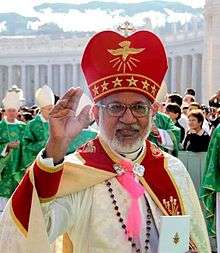

East Syriac liturgy has three anaphorae: those of the Holy Apostles (Saints Addai and Mari), Nestorius, and Theodore the Interpreter. The first is the most popularly and extensively used. The second was traditionally used on the Epiphany and the feasts of St. John the Baptist and of the Greek Doctors, both of which occur in Epiphany-tide on the Wednesday of the Rogation of the Ninevites, and on Maundy Thursday. The third is used (except when the second is ordered) from Advent to Palm Sunday. The same pro-anaphoral part (Liturgy of the Word) serves for all three.
In the second half of the 20th century, there was a movement for better understanding of the liturgical rites. A restored Eucharistic liturgy, drawing on the original East Syriac sources, was approved by Pope Pius XII in 1957, and for the first time on the feast of St. Thomas on 3 July 1962 the vernacular, Malayalam, was introduced for the celebration of the Syro-Malabar Qurbana.[40] Currently they celebrate the Divine Liturgy of Addai and Mari and the Anaphora of Theodre in mostly Malayalam, with Syriac and English influences.
Besides the Anaphora of Addai and Mari being used currently in Syro-Malabar liturgy, there are two more anaphorae known as Anaphora of Theodore and Anaphora of Nestorius. That the Anaphora of Theodore which was withdrawn from use after the Synod of Diamper (a large number of churches used it up to 1896) is being used again in the Syro-Malabar Church after 415 years is indeed an important historical reality. In a way the Syro-Malabar church rejected the Synod of Diamper. Pope Pius XII during the process of restoration of the Syro-Malabar Qurbana in 1957 had requested the restoration of the Anaphorae of Theodore and Nestorius. The draft of the Anaphora of Theodore was restored after meticulous study by the Central Liturgical Committee, Liturgical Research Centre, various sub-committees, and the eparchial liturgical commissions. Many changes befitting to the times have been made in the prayers, maintaining maximum fidelity to the original text of the Second Anaphora. It was this text so prepared that was sent to Rome for the recognition of the Apostolic See in accordance with the decision of the Syro-Malabar Synod. The Congregation for the Eastern Churches gave its approval for using this anaphora on an experimental basis for three years on 15 December 2012.[41]
After almost 420 years, the Anaphora of Nestorius is restored in the Syro-Malabar Church.[42] The aftermath of the so-called Synod of Diamper was that any texts related to Nestorius were systematically burnt by the Jesuits, who represented and ruled the Latin Church of India in 1599. In a way, the SyroMalabar church rejected the Synod of Diamber (Udayamperoor) by restoring the Anaphora of Theodore and Anaphora of Nestorius.
The Latinization of the Syro-Malabar rite churches was brought to a head when in 1896 Ladislaus Zaleski, the Apostolic Delegate to India, requested permission to translate the Roman Pontifical into Syriac. This was the choice of some Malabar prelates, who chose it over the East Syriac Rite and West Syriac Rite pontificals. A large number of Syro-Malabarians were Assyrian schismatics at that time and various problems and concerns delayed the approval of this translation, until in 1934 Pope Pius XI stated that Latinization was no longer to be encouraged among Eastern Rite Catholics.[43] He initiated a process of liturgical reform that sought to restore the oriental nature of the Latinized Syro-Malabar rite.[44] A restored Eucharistic liturgy, drawing on the original East Syriac sources, was approved by Pius XII in 1957 and introduced in 1962.
The church uses one of several Bible translations into Malayalam.
Liturgical calendar

Syro Malabar Church has its own liturgical year. It is ordered according to the flow of salvation history, and focuses on the historical life of Jesus.[45] There are nine seasons for the liturgical year. They are:
- Annunciation (Suvara)
- Epiphany (Denha)
- Great Fast (Sawma Rabba)
- Resurrection (Qyamta)
- Apostles (Slihe)
- Summer (Qaita)
- Elijah-Cross-Moses (Elijah-Sliba-Muse)
- Dedication of the Church (Qudas-Edta)
Major feasts

Major feasts of the Church are:[46]
- Dukrana of the Father in Faith – Thoma Shliha – commemorated 3 July
- Alphonsa – commemorated 28 July
- Saint Kuriakose Elias Chavara – commemorated 3 January
- Varghese Payyappilly Palakkappilly – commemorated 5 October
- Saint Euphrasia – commemorated 29 August
- Bartholomeo Sleeha – commemorated 24 August
- Shmoni and her 7 Children – commemorated 21 August
- The Assumption of St Mary (Shoonaya) – commemorated on 15 August
- Transfiguration (Geliyana) – commemorated 6 August
- Addai and Mari – commemorated on the Second Friday of Qaita (Summer)
- The 12 Apostles of our Lord, Iso' Misiha – commemorated 19 July
- The 70 Apostles – commemorated 17 July
- Quriaqos and mother Yolethe – commemorated 15 July
- Aprem – commemorated 9 June
- Blessed Mariam Thresia – commemorated 8 June
- Holy Pentecost – commemorated on 31 May
- The Ascension of our Lord, Iso' Misiha (Sulaqa) – commemorated 21 May
- Addai Shliha – commemorated 10 May
- Geevarghese Sahada – commemorated 24 April
- New Sunday – commemorated 19 April
- All Saints' Day – commemorated on the first Friday of the Season of Resurrection
- Entry of our Lord, Iso' Misiha into Jerusalem – Oshana Sunday
- The Annunciation of St Mary (Subara) – commemorated 25 March
- Remembrance of all Departed Faithful (Kol Anidhe) – commemorated on Last Friday of Denha
- The feast of Denha, the Epiphany – commemorated on 6 January
- The Nativity of our Lord, God and Saviour Iso M'siha (Yaldha) – commemorated 25 December
- Immaculate Conception of St Mary – commemorated 8 December
- Augustinose Kunjachan – commemorated 16 October
- Passover Feast (Pesha)
Syro-Malabar hierarchy
List of Major Archbishops
Also known as Metropolitan and Gate of all India, the Major Archbishops of the Syro-Malabar Catholic Church are:
- Antony Padiyara (1992–1997)
- Varkey Vithayathil (1997–2011)
- George Alencherry (2011–present)
Syro-Malabar major archiepiscopal curia
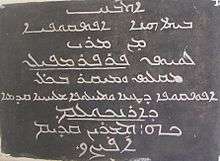
The curia[47] of the Syro-Malabar Church began to function in March 1993 at the archbishop's house of Ernakulam-Angamaly. Later, on 27 May 1995, it was shifted to new premises at Mount St. Thomas near Kakkanad, Kochi. The newly-constructed curial building was opened on 3 July 1998.
The administration of the Syro-Malabar Church has executive and judicial roles. The major archbishop, officials, various commissions, committees, and the permanent synod form the executive part. The permanent synod and other offices are formed in accordance with the Code of Canons of the Eastern Churches (CCEO). The officials include the chancellor, vice-chancellor, and other officers. Various commissions are appointed by the major archbishop: Liturgy, Pastoral Care of the Migrant and Evangelisation, Particular Law, Catechism, Ecumenism, Catholic Doctrine, Clergy and Institutes of Consecrated Life, and Societies of Apostolic Life. The members of the commissions are ordinarily bishops, but include priests. For judicial activities there is the major archiepiscopal ordinary tribunal formed in accordance with CCEO which has a statutes and sufficient personnel, with a president as its head. At present, Rev. Dr. Jose Chiramel is the president. The Major archiepiscopal curia functions in the curial building in Kerala, India. They have prepared the particular law for their Church and promulgated it part by part in Synodal News, the official Bulletin of this Church. There are statutes for the permanent synod and for the superior and ordinary tribunals. CCEO c. 122 § 2 is specific in the particular law, that the term of the office shall be five years and the same person shall not be appointed for more than two terms consecutively.[48]
Provinces, (Arch)Eparchies and other jurisdictions
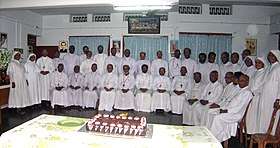
There are 35 eparchies (dioceses). Five of them are Archeparchies (of major archbishop) at present, all in southern India: Ernakulam-Angamaly, Changanacherry, Trichur, Tellicherry, and Kottayam.
These have another 13 suffragan eparchies: Bhadravathi, Belthangady, Irinjalakuda, Kanjirapally, Kothamangalam, Idukki, Mananthavady, Mandya, Palai, Palghat, Ramanathapuram, Thamarassery, and Thuckalay within the canonical territory of the Major Archiepiscopal Church.
There are 13 further eparchies outside the canonical territory of which Adilabad, Bijnor, Chanda, Gorakhpur, Jagdalpur, Kalyan, Rajkot, Sagar, Satna, Faridabad, Hosur, Shamsabad, and Ujjain in India are with exclusive jurisdiction. The St. Thomas Eparchy of Chicago in the United States of America, St. Thomas the Apostle Eparchy of Melbourne in Australia, Eparchy of Great Britain, and Eparchy of Mississauga, Canada enjoy personal jurisdiction.[49]
Proper Ecclesiastical provinces
Most believers of this church are organized under five metropolitan archeparchies (archdioceses), all in Kerala, and their suffragan eparchies.

- Major Archeparchy of Ernakulam-Angamaly
- Metropolitan Archeparchy Changanassery
- Eparchy of Kanjirappally
- Eparchy of Palai
- Eparchy of Thuckalay
- Archeparchy of Kottayam (nominally Metropolitan, no suffragan; exclusively for the Knanaya Catholic faithful)
- Metropolitan Archeparchy of Tellicherry
- Metropolitan Archeparchy of Thrissur
Eparchies Outside Kerala
Exempt jurisdictions
- Eparchy of Faridabad, near Delhi, also serves Haryana, (Indian) Punjab, Himachal Pradesh, Jammu and Kashmir and parts of Uttar Pradesh
- Eparchy of Hosur, in Tamil Nadu, established October 2017[50]
- Eparchy of Shamshabad, includes the entire country of India not included in existing eparchies, established October 2017[50]
Outside India:
- Eparchy of Mississauga, for Canada
- Eparchy of Melbourne, for Australia
- Eparchy of Chicago, for the USA
- Eparchy of Great Britain in Preston, England for England, Wales & Scotland
Syro-Malabar Religious Congregations
The Religious Congregations are divided in the Eastern Catholic Church Law (Code of Canons of the Oriental Churches – CCEO) as Monasteries, Hermitages, Orders, Congregations, Societies of Common Life in the Manner of Religious, Secular Institutes, and Societies of Apostolic Life.
Active are :
- Carmelites of Mary Immaculate
- Congregation of the Mother of Carmel
- Little Flower Congregation
- Franciscan Clarist Congregation
- Missionary Congregation of the Blessed Sacrament
- Missionary Society of Saint Thomas the Apostle
- Sisters of the Adoration of the Blessed Sacrament (Adoration Congregation)
- Sisters of the Destitute (S.D.)
- Vincentian Congregation
- Nazareth Sisters
Syro-Malabar Major Archiepiscopal Churches
- St. Mary's Syro-Malabar Major Archiepiscopal Church Kuravilangad, Pala Diocese
- St. Mary's Knanaya Catholic Forane Church (Valiya palli) Kaduthuruthy, Kottayam Archdiocese
- Holy Cross Forane Church Nadavayal, Manathavady Diocese
- St. Mary's Forane Church Kudamaloor, Changanacherry Archidiocese
- St. Thomas Syro-Malabar Church Palayoor, Thrissur Archidiocese
- St. Sebastian Church Thazhekad, Irinjalakuda Diocese
- St. Mary's Church Kanjirappally Akkarappally, Kanjirappally Diocese
Statistics
| Institutions | # |
|---|---|
| Parishes | 3,224 |
| Quasi-parishes | 539 |
| Missions | 490 |
| Institutes of consecrated life – men & women | 53 |
| Major & minor seminary | 71 |
| Regular, technical & other colleges | 691 |
| Teachers' training institutes | 24 |
| Engineering colleges
Higher Secondary & Primary Schools |
29
2,981 |
| Kindergartens | 1,685 |
| Non-formal & adult education | 503 |
| Special schools | 4,021 |
| Health care institutions | 700 |
| Nurse's training schools | 44 |
| Hospitals, dispensaries & health centers
Medical colleges |
670
5 |
| Specialized health care centers, incurables & leprosy care centers | 54 |
| Old age homes | 211 |
| Children's homes | 185 |
| Orphanages | 230 |
| Rehabilitation centers and other institutions | 1,616 |
| Total | 13,805 |
| Personnel | |
| Religious sisters | 35,000 |
| Religious brothers | 6,836 |
| Seminarians | 2,907 |
| Diocesan and religious priests | 9,121 |
| Bishops | 56 |
| Major archbishop | 1 |
| Total | 51,097 |
According to the Annuario Pontificio (the pontifical yearbook) for 2016 there were about 4,189,349 members in the Syro-Malabar Church.[49]
Within the proper territory
There are sixteen eparchies in the proper territory of the Syro-Malabar Church.
Archeparchy of Ernakulam-Angamaly has 510,000 members with 347 parishes, 731 religious/secular priests, 632 male religious and 4935 female religious. Archeparchy of Trichur has 471,328 members with 195 parishes, 418 religious/secular priests, 358 male religious and 3315 female religious. Eparchy of Idukki has 270,000 members with 129 parishes, 119 religious/secular priests, 109 male religious and 1320 female religious.
Archeparchy of Changanacherry has 390,000 members with 266 parishes, 615 religious/secular priests, 534 male religious and 2705 female religious. Eparchy of Palai has 348,128 members with 169 parishes, 502 religious/secular priests, 127 male religious and 3312 female religious. Archeparchy of Tellicherry has 317,782 members with 222 parishes, 293 religious/secular priests, 263 male religious and 1664 female religious. Eparchy of Irinjalakuda has 258,200 members with 128 parishes, 233 religious/secular priests, 132 male religious and 2350 female religious.
Eparchy of Kothamangalam has 217,420 members with 115 parishes, 242 religious/secular priests, 163 male religious and 2210 female religious. Eparchy of Kanjirapally has 192,000 members with 136 parishes, 314 religious/secular priests, 210 male religious and 1840 female religious. Archeparchy of Kottayam has 175,300 members with 149 parishes, 161 religious/secular priests, 107 male religious and 1233 female religious. Eparchy of Mananthavady has 170,100 members with 140 parishes, 413 religious/secular priests, 358 male religious and 1546 female religious. Eparchy of Thamarasserry has 129,600 members with 128 parishes, 247 religious/secular priests, 257 male religious and 1321 female religious. Eparchy of Palghat has 68,004 members with 106 parishes, 167 religious/secular priests, 82 male religious and 1360 female religious.[49]
According to a study, in Kerala about 30 percent of the Syro Malabar Church members lived in the erstwhile Cochin State. The remaining 70 percent lived in Travancore state. In the Travancore state, Meenachil Taluk had the largest proportion, followed by Changanaserry Taluk.
Erstwhile Cochin State, Meenachil (Palai) and Changanaserry together had 56 percent of the total Syro Malabar population. Kottayam, Pala, Muvattupuzha, Kanjirappally, Thodupuzha, Kothamangalam, Cherthala, Mukundapuram (irinjalakkuda-chalakkudy), Wadakkancherry, Thrissur, North Parur, Alwaye, Kunnathunadu, Ambalapuzha, Kuttanad, Peerumedu, Nedumkandam and Devikulam etc. are the prominent taluks.[49]
Outside the proper territory
There are eleven eparchies outside the proper territory of the Syro Malabar Church.
The Eparchy of Kalyan has 100,000 members with 106 parishes, 146 religious/secular priests, 105 male religious and 270 female religious. St. Thomas Syro-Malabar Catholic Diocese of Chicago, USA, has 85,000 members with 11 parishes, 45 religious/secular priests, 13 male religious and 16 female religious. The Eparchy of Canada has 14,079 members with 5 parishes, 51 religious/secular priests, 182 male religious and 352 female religious. The Eparchy of Adilabad has 13,273 members with 25 parishes, 50 religious/secular priests, 41 male religious and 143 female religious. The Eparchy of Rajkot has 12,850 members with 12 parishes, 140 religious/secular priests, 142 male religious and 421 female religious. There is a significant diaspora of Syro-Malabar Catholics in countries not under the jurisdiction of any of the existing eparchies.[52]
Saints, Blesseds, Venerables and Servants of God
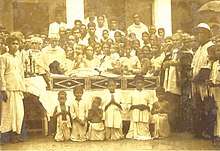
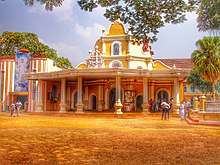
Saints
- Thoma Sliha – apostle and founder of the Syro-Malabar Church
- Alphonsa – religious sister of FCC congregation
- Kuriakose Elias Chavara – priest and founder of CMI
- Euphrasia Eluvathingal – religious sister of CMC congregation
- Mariam Thresia Chiramel – religious sister and founder of Holy Family congregation
Beatified people
- Augustine Thevarparambil (Kunjachan) – priest
- Rani Maria (1954–1995) – religious sister of FCC congregation
Venerables
- Payyappilly Varghese Kathanar – priest and founder of Sisters of the Destitute (1876–1929)
- Thomas Kurialachery – first bishop of Archeparchy of Changanassery (1872–1925)
- Kadalikkattil Mathai Kathanar – priest (1872–1935)
- Joseph Vithayathil – priest and co-founder of Holy Family congregation (1865–1964)
- Augustine John Ukken – priest and Congregation of Sisters of Charity (CSC) (1880–1956)
Servants of God
- Tommiyachan Poothathil, (1871–1943)
- Mary Celine Payyappilly (1906–1993)
- Joseph C. Panjikaran (1888–1949)
- Antony Thachuparambil (1894–1963)
- Mathew Kavukatt (1904–1969)
- Maria Celine Kannanaikal (1931–1957)
- Thommachen Puthenparampil
- Canisius CMI (1914–1998)
- Mother Mary Francisca de Chantal Vallayil SABS (1880–1972)
- Varkey Kattarath VC
- Joseph Kandathil
List of prominent Syro-Malabar Catholics in history
Prominent Syro-Malabar Catholics who worked for unity of Nasranis
- Joseph Kariattil
- Paremmakkal Thoma Kathanar
- Nidhiry Mani Kathanar
- Placid J. Podipara
- Joseph Powathil
- Thelly Mani Malpan
- Koonammakkal Thoma Kathanar
Varthamanappusthakam
The Varthamanappusthakam is the first travelogue written in the Malayalam language, written by Paremmakkal Thoma Kathanar. It describes the history of the Nasrani Church between the years 1773 and 1786 with emphasis on the journey of its author and Malpan Ousep (Joseph) Kariattil from Malabar to Rome via Lisbon and back. Despite attempts by European ecclesiastical authorities to destroy it, the major part of this book survived.
Shared history with other Saint Thomas Christians
Abraham of Angamaly
Abraham of Angamaly (Syriac: ܐܒܪܗܡ ܡܛܪܢ, Abraham died c. 1597) was the last in the long line of Mesopotamian Bishops who governed the Church of Saint Thomas Christians. In spite of the express approbation of the pope, he was not welcomed by the Portuguese ecclesiastical authorities.
Abraham died in January 1597 at Angamaly and his body was buried in Hormiz Syro-Malabar Catholic Church, Angamaly (old Cathedral church).
See also
References
- https://www.britannica.com/topic/Peshitta
- https://archive.org/details/eastsyriactheolo0000paul/page/n4/mode/2up
- "The Major Archiepiscopal Curia".
- "Eparchial Sees in the Syro-Malabar Church".
- Encyclopaedia of sects & religious doctrines, Volume 4 By Charles George Herbermann page 1180,1181
- Fernando, Leonard; Gispert-Sauch, G. (2004). Christianity in India: Two Thousand Years of Faith. p. 79. ISBN 9780670057696.
The community of the St Thomas Christians was now divided into two: one group known as the 'old party' joined in communion with the Western Church and in obedience to the Pope whose authority they recognized in the archbishop of Goa. The 'new party' (Puttankuttukar) stayed with Mar Thoma and eventually came under the influence of and entered into communion with the West Syrian Church of Antioch
- Robert Eric Frykenberg (2008). Christianity in India: From Beginnings to the Present. p. 361. ISBN 9780198263777.
His followers became known as the 'new party' (Puthankuttukar), as distinct from the 'old party' (Pazhayakuttukar), the name by which the Catholic party became known.
- Hillerbrand, Hans J. (2004). Encyclopedia of Protestantism: 4-volume Set. Routledge. ISBN 9781135960285.
those who rejected the Latin rite were known as the New Party, which later became the Jacobite Church
- MSS Vat Syr 204a and Paris BN Syr 25
- "The Eastern Catholic Churches 2017" (PDF).
- St. Raphael Syro Malabar Catholic Mission of Cleveland (2014)
- "The Syro-Malabar Church Today: An Overview::The St. Thomas Christians::East Syrian (Chaldean)::Syro-Malabar Major Archiepiscopal Church". www.syromalabarchurch.in. Retrieved 28 February 2020.
- George Menachery (1973) The St. Thomas Christian Encyclopedia of India, Ed. George Menachery, B.N.K. Press, vol. 2, ISBN 81-87132-06-X, Lib. Cong. Cat. Card. No. 73-905568; B.N.K. Press – (has some 70 lengthy articles by different experts on the origins, development, history, culture... of these Christians, with some 300 odd photographs).
- Leslie Brown, (1956) The Indian Christians of St. Thomas. An Account of the Ancient Syrian Church of Malabar, Cambridge: Cambridge University Press 1956, 1982 (repr.)
- Thomas Puthiakunnel, (1973) "Jewish colonies of India paved the way for St. Thomas", The Saint Thomas Christian Encyclopedia of India, ed. George Menachery, Vol. II., Trichur.
- Frykenberg, pp. 102–107; 115.
- Mihindukulasuriya, Prabo. "Persian Christians in the Anuradhapura Period". Academia.edu. Retrieved 19 December 2018.
- "St. Gregorios Malankara (Indian) Orthodox Church of Washington, DC : Indian Orthodox Calendar". Stgregorioschurchdc.org. Retrieved 19 December 2018.
- "Mar Aprem Metropolitan Visits Ancient Anuradhapura Cross in Official Trip to Sri Lanka". Assyrian Church News. 6 August 2013. Archived from the original on 26 February 2015. Retrieved 1 March 2015.
- Addai and Mari, Liturgy of. Cross, F. L., ed. The Oxford Dictionary of the Christian Church. Oxford University Press. 2005
- P. Malekandathil (2003). St. Thomas Christians: A Historical Analysis of their Origin and Development up to 9th Century AD, from St.Thomas Christians and Nambudiris Jews and Sangam Literature: A Historical Appraisal. Kochi, India: Bosco Puthur (ed.) LRC Publications).
- Stephen Neill, A History of Christianity in India: The Beginnings to AD 1707, pp. 326-27
- "Museum". The Syro-Malabar Church. Archived from the original on 29 October 2007. Retrieved 28 September 2013.
- "CHRONOLOGY OF EVENTS IN THE HISTORY OF THE SYROMALABAR CHURCH". Syro-Malabar Church Official website. Retrieved 13 August 2020.
- George Joseph Nedumparambil (2013). "A Search of the Roots of the Syro-Malabar Church in Kerala" (PDF). University of Würzburg. Retrieved 19 September 2019.
- Wilfred, Felix (2014). The Oxford Handbook of Christianity in Asia. Oxford University Press, USA. ISBN 978-0-19-932906-9.
- Roberson, Ronald. "The Syro-Malankara Catholic Church". E Catholic Near East Welfare Association. Retrieved 2 August 2018.
- Habbi 1966, p. 99-132, 199-230.
- Wilmshurst 2000, p. 21-22.
- "Koonan Oath 00001" (PDF). Archived from the original (PDF) on 27 June 2011. Retrieved 20 May 2007.
- Gregorios & Roberson, p. 285.
- Vadakkekara, p. 91.
- Eugene Cardinal Tisserant, "Eastern Christianity in India"
- Catholic Encyclopedia profile of "St. Thomas Christians" - The Carmelite Period
- Thekkedath, History of Christianity in India"
- Roberson, Ronald. "The Syro-Malabar Catholic Church". CNEWA.
- "Presentation of the Pontifical Yearbook 2019 and the Annuarium Statisticum Ecclesiae 2017". Holy See Press Office. 6 March 2019. Archived from the original on 7 March 2019. Retrieved 6 March 2019.
- Fr. George Thalian: "The Great Archbishop Mar Augustine Kandathil, D. D.: the Outline of a Vocation". Retrieved 27 April 2011., Mar Louis Memorial Press, 1961. (Postscript) (PDF).
- Divine Praises in Aramaic Tradition by Pathikulangara Varghese Kathanar
- The Origin and Progress of the Syro-Malabar Hierarchy By Varkey J. Vithayathil
- Official Website
- "Syro Malabar News Updates". www.syromalabarchurch.in. Retrieved 28 February 2020.
- The Synod of Diamper and the Liturgy Jacob Vellian The Synod of Diamper Revisited, George Nedugatt, ed.
- A Study of the Syro-Malabar Liturgy (George Vavanikunnel)
- Pathikulangara, Varghese. Mar Thomma Margam (A New Catechism for the St. Thomas Christians of India), Kottayam: Denha Services, 2004
- Syro Malabar Church-Major Feasts, The Nazrani. Also major article on the same in The St. Thomas Christian Encyclopaedia of India Vol. II
- Francis Eluvathingal, Patriarchal and Major Archiepiscopal Churches in the Eastern Catholic Legislations based on CCEO Canon 114–125
- Francis Eluvathingal, Syro-Malabar Church Since the Eastern Code
- , Syro Malabar Church: An Overview.
- "Provisions for the Syro-Malabar Church, 10.10.2017" (Press release). Holy See Press Office. Retrieved 24 May 2018.
- At a Glance Archived 2009-09-04 at the Wayback Machine, Syro Malabar Church Website.
- "Syro-Malabar Church Dublin Ireland". Retrieved 27 August 2016.
References and bibliography
- ASSEMANI, Bibliotheca Orientalis (Rome, 1719–28); DE SOUZA.
- Orientale Conquistado (2 vols., Indian reprint, Examiner Press, Bombay).
- Gouvea, Jornada do Arcebispo Aleixo de Menezes quando foy as Serra do Malaubar (Coimbra, 1606).
- Fr. tr. De Glen, Histoire Orientale etc. (Brussels, 1609); DU JARRIC.
- Thesaurus rerum mirabilium in India Orient (3 vols., Cologne, 1615).
- India Orientalis Christiana (Rome, 1794).
- Mackenzie, Christianity in Tranvancore, with Census Report of 1901 (Trivandrum). Ed.& Reprinted, Prof. George Menachery in the Nazranies i.e. The Indian Church History Classics I, 1998.
- Medlycott, India and the Apostle St. Thomas (London, 1905). Ed. & Reprinted, Prof. George Menachery in the Nazranies i.e. The Indian Church History Classics I, 1998.
- Thalian, Fr. George: "The Great Archbishop Mar Augustine Kandathil, D. D.: the Outline of a Vocation"., Mar Louis Memorial Press, 1961. (Postscript) (PDF).
- Menachery G (1973) The St. Thomas Christian Encyclopedia of India, Ed. George Menachery, B.N.K. Press, vol. 2, ISBN 81-87132-06-X, Lib. Cong. Cat. Card. No. 73-905568; B.N.K. Press – (has some 70 lengthy articles by different experts on the origins, development, history, culture ... of these Christians, with some 300 odd photographs). Vol. 1, 1982. Vol. 3, 2010.
- Mundadan, A. Mathias. (1984) History of Christianity in India, vol. 1, Bangalore, India: Church History Association of India.
- Podipara, Placid J. (1970) "The Thomas Christians". London: Darton, Longman and Tidd, 1970. (is a readable and exhaustive study of the St. Thomas Christians.)
- Philip, E. M. (1908) The Indian Christians of St. Thomas (1908; Changanassery: Mor Adai Study Center, 2002).
- Aprem, Mar. (1977) The Chaldaean Syrian Church in India. Trichur, Kerala, India: Mar Narsai, 1977.
- Menachery, Professor George. (2000) Kodungallur – The Cradle of Christianity in India, Thrissur: Marthoma Pontifical Shrine.
- Menachery, Professor George & Snaitang, Dr. Oberland (2012)"India's Christian Heritage". The Church History Association of India, Dharmaram College, Bangalore.
- Acts of St. Thomas (Syriac) MA. Bevan, London, 1897
- Tisserant, E. (1957) Eastern Christianity in India: A History of the Syro-Malabar Church from the Earliest Times to the Present Day. Trans. and ed. by E. R. Hambye. Westminster, MD: Newman Press.
- Michael Geddes, (1694) A Short History of the Church of Malabar together with the Synod of Diamper, London. Ed. Prof. George Menachery in the Nazranies i.e. The Indian Church History Classics I, 1998.
- Puthur, B. (ed.) (2002): The Life and Nature of the St Thomas Christian Church in the Pre-Diamper Period (Cochi, Kerala).
- T.K Velu Pillai, (1940) "The Travancore State Manual"; 4 volumes; Trivandrum
- Menachery G (ed); (1998) "The Indian Church History Classics", Vol. I, The Nazranies, Ollur, 1998. ISBN 81-87133-05-8.
- Menachery, George. Glimpses of Nazraney Heritage.SARAS 2005 Ollur.
- Palackal, Joseph J. Syriac Chant Traditions in South India. PhD, Ethnomusicology, City University of New York, 2005.
- Joseph, T. K. The Malabar Christians and Their Ancient Documents. Trivandrum, India, 1929.
- Leslie Brown, (1956) The Indian Christians of St. Thomas. An Account of the Ancient Syrian Church of Malabar, Cambridge: Cambridge University Press 1956, 1982 (repr.)
- Thomas P. J; (1932) "Roman Trade Centres in Malabar", Kerala Society Papers II.
- Marco Polo.(1298) LATHAM, R. (TRANSL.) "The Travels" Penguin Classics 1958
- Bjorn Landstrom (1964) "The Quest for India", Double day English Edition, Stockholm.
- Francis Eluvathingal (ed), Syro-Malabar Church Since the Eastern Code, Mary Matha Publications, Trichur, 2003.
- Francis Eluvathingal, "Patriarchal and Major Archiepiscopal Curia in the Eastern Catholic Legilations based on CCEO Canons 114–125" ORISI, Kottayam, 2009.
External links
| Wikimedia Commons has media related to Syro-Malabar Catholic Church. |
- Syro-Malabar Church
- Archdiocese of Thrissur
- Archdiocese of Kottayam
- Archdiocese of Changanacherry
- Archdiocese of Ernakulam-Angamaly
- Archdiocese of Tellicherry
- The website for Synod of Diamper
- Indian Christianity : Books by Geddes, Mackenzie, Medlycott, &c.
- The Chennai Mission
- Syro malabar mission in Chennai
- Syro Malabar Church in Australia
- Nazraney Heritage
- Syro Malabar Church in Qatar
- Syro Malabar Matrimony
- Article on the Syro-Malabar Catholic Church by Ronald Roberson on the CNEWA web site
- Fathima Matha Church, East Hill , Kozhikode
